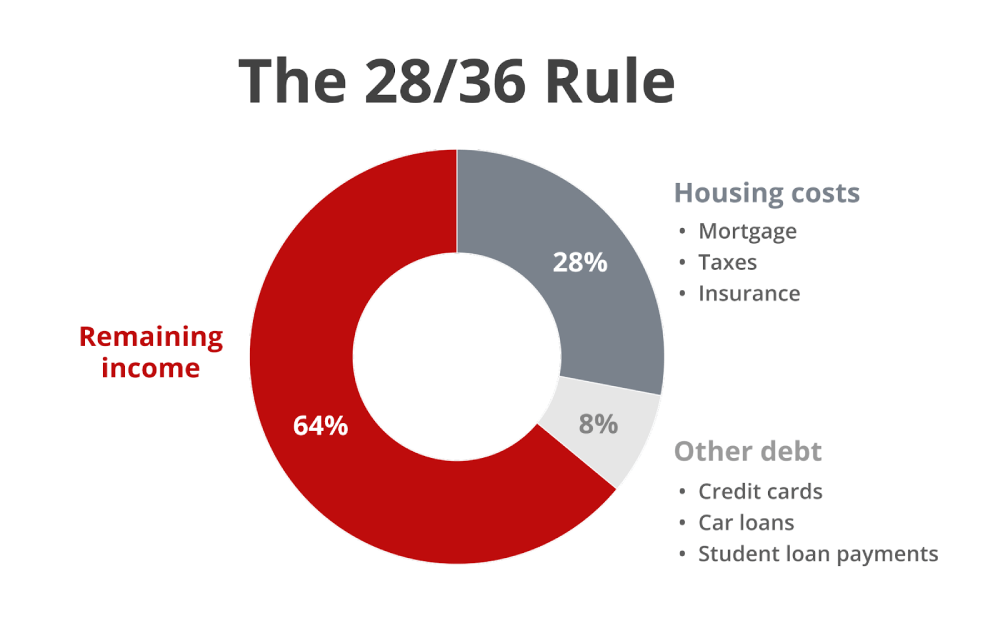How Much of Your Income Should Go to Your Mortgage?
KEY TAKEAWAYS
- It’s often recommended that home buyers spend no more than 28% of their gross monthly income on their mortgage.
- The 28/36 rule also limits total monthly debt payments to 36% of your income.
- Factors like income stability, credit score, and down payment can affect how much mortgage you can afford.



 Outstanding Client Experience
Outstanding Client Experience Specialized Lending Solutions
Specialized Lending Solutions Direct-to-Consumer Advantage
Direct-to-Consumer Advantage We're Advisors, NOT Salespeople
We're Advisors, NOT Salespeople Effortless Digital Mortgage Platform
Effortless Digital Mortgage PlatformBuying a home is one of the biggest financial decisions you can make, but just because you’re approved for a specific loan amount doesn’t mean you should borrow it all.
Finding the right mortgage budget comes down to a smart calculation: how much of your income should go to your mortgage? Getting this number right can help you avoid financial stress and stay on track with your long-term goals.
In this blog, we’ll break down how to better understand your mortgage-to-income ratio and how that determines what percentage of income should go to housing.

KEY TAKEAWAYS
- It’s often recommended that home buyers spend no more than 28% of their gross monthly income on their mortgage.
- The 28/36 rule also limits total monthly debt payments to 36% of your income.
- Factors like income stability, credit score, and down payment can affect how much mortgage you can afford.
Why It’s Important to Set a Mortgage Budget
A house you can afford today should still be affordable tomorrow. Overspending on a mortgage can leave you “house poor,” meaning most of your income goes to your home, leaving little for savings, travel, or emergencies.
Setting a mortgage budget isn’t just smart; it’s a requirement for loan approval. Lenders use a debt-to-income (DTI) ratio to determine if you qualify. By knowing your budget, you can avoid overextension and reduce the risk of default.
Sticking to a budget also frees up money for other long-term goals, like retirement savings, emergency funds, and family expenses. It gives you flexibility and peace of mind, especially if you face job changes or medical emergencies.
And remember: just because you’re approved for a larger mortgage doesn’t mean you should take it. Think of your financial goals in five, ten, or even twenty years. Will your home still allow room for savings, investments, and life’s unexpected expenses?
What Percentage of Income Should Go to a Mortgage?
The general recommendation is that no more than 28% of your gross monthly income should go toward your mortgage payment. This includes:
- Principal
- Interest
- Property taxes
- Homeowners insurance
This percentage, known as your mortgage-to-income ratio, helps keep your overall budget balanced and can assist in determining whether to rent or buy. For example, if you earn $6,000 per month, aim for a mortgage payment of $1,680 or less.
Of course, this guideline may shift slightly based on your financial goals. Some may be comfortable spending a bit more if they live in high-cost areas or have minimal other debts. However, staying close to that 28% threshold is a good way to build a stable financial foundation.
Housing Costs vs Total Debt: The 28/36 Rule

When understanding how much of your income should go to a mortgage, people often follow the 28/36 rule. While the 28% rule covers housing expenses, the 28/36 rule provides a fuller financial picture. According to this guideline:
- No more than 28% of your gross income should go to housing costs
- No more than 36% of your gross income should go to all debt, including credit cards, student loans, and car payments
This standard helps lenders assess risk and ensures you’ll still have breathing room in your monthly budget. If your total debt exceeds 36%, you may need to consider a smaller loan or larger down payment.
Understanding this rule can help you make better decisions when shopping for a home. Even if you’re approved for a larger loan, aim to stay within this framework to avoid financial strain.
Factors That Influence How Much Your Mortgage Should Be
Your ideal mortgage isn’t just a matter of percentages. Consider these key factors when setting aside a percentage of your salary for a mortgage:
- Income stability: Individuals with a low income or irregular income may need to adopt more conservative budgeting practices.
- Existing debt: High debt payments lower the amount you can safely allocate to housing.
- Down payment size: A larger down payment lowers monthly costs and can help avoid private mortgage insurance (PMI), which is usually added to a mortgage if the down payment is less than 20%.
- Credit score: Better scores usually qualify for lower interest rates.
- Loan type: Whether you’re applying for a conventional loan or a non-QM loan can affect terms and limits.
- Location: The cost of living and local housing market dynamics are key factors to consider.
- Household size and dependents: Larger households may face higher living costs outside of housing, as there are more people to support.
- Lifestyle priorities: Frequent travel or high education expenses could mean adjusting your mortgage budget accordingly.
Fixed vs Variable Expenses in Mortgage Planning
As you determine the percentage of your income that should go toward a mortgage, it helps to understand the difference between fixed and variable expenses. Fixed expenses are costs that you can expect to remain the same each month, while variable expenses can change from month to month depending on different factors.
These additional costs are often easy to overlook but essential to consider when determining the amount of your mortgage.

Fixed expenses:
- Mortgage principal and interest
- Property taxes
- Homeowners insurance
- HOA fees (if applicable)
Variable expenses:
- Utilities (electric, gas, water, internet)
- Home maintenance and repairs
- Landscaping
- Appliance replacements
- Security systems or smart home subscriptions
Planning for both types of expenses ensures your monthly housing costs don’t unexpectedly balloon beyond your income limits. For example, even if your mortgage fits comfortably within the 28% rule, rising utility costs or an unexpected roof repair can throw your budget off track.
To stay prepared, set aside a home maintenance fund and revisit your budget quarterly. A proactive approach to both fixed and variable costs is crucial to sustaining homeownership and keeping your financial goals within reach.
How Lenders Evaluate Mortgage Affordability
Lenders assess whether you can afford a mortgage by analyzing your:
- Gross monthly income: This is the foundation for determining what size mortgage payment you can manage. Lenders look for consistent, verifiable income through pay stubs, W-2s, or tax returns.
- Debt-to-income (DTI) ratio: This measures how much of your monthly income goes toward debt payments. A lower DTI means you have more income available to handle new housing expenses.
- Credit report and score: Your credit history influences your interest rate and loan eligibility. A strong credit score typically results in better loan terms and broader options.
- Employment history: Lenders prefer borrowers with at least two years of steady employment in the same field, which shows stability and reliability.
- Assets and reserves: These include savings, retirement accounts, and other investments that can cover closing costs or unexpected expenses.
During the pre-approval process, lenders require documentation to verify your financial standing. This typically includes pay stubs, W-2s, tax returns, and recent bank statements. These documents help confirm your income consistency, evaluate outstanding debts, and determine how much financial cushion you have to cover your housing expenses.
Lenders calculate your DTI ratio by dividing your total monthly debt payments by your gross monthly income. A lower DTI ratio signals to lenders that you’re less risky and more capable of handling a mortgage. Most lenders prefer a DTI of 43% or lower, but aiming for the 28/36 rule is optimal.
For self-employed individuals or those with non-traditional income sources, lenders might ask for profit and loss statements or several years of tax returns. In such cases, a non-QM loan can provide the flexibility that traditional loans may not offer.
Lenders may also consider your future earning potential, particularly in professions with a predictable upward income trajectory. For example, medical residents, law clerks, or graduate students may have low current earnings but significant future income, which some lenders factor into the approval process.
Find a Mortgage That Works With Your Budget

At the end of the day, the best mortgage is the one you can comfortably afford, both now and in the future. Whether you’re buying with a low income or earning six figures, the same principle applies: don’t stretch your budget too thin.
Your mortgage should allow you to live, not just survive. That means having enough left over each month for savings, hobbies, travel, and emergency expenses. It also means choosing a loan structure that matches your financial habits and life goals. Maybe you need the predictability of a fixed-rate mortgage, or perhaps the flexibility of a non-QM loan better suits your income type.
With Griffin Funding, you get access to personalized lending options, including conventional loans, non-QM loans, and even digital tools like the Griffin Gold app to keep your mortgage planning on track.
Ready to run the numbers and find a mortgage that fits? Start with Griffin Funding and unlock mortgage solutions that support your home buying goals.
Find the best loan for you. Reach out today!
Get StartedRecent Posts
Best DSCR Lenders: Griffin Funding vs Angel Oak vs Kiavi vs Visio vs Lima One vs Easy Street
What to Look for in a DSCR Lender Choosing the best DSCR lender for your unique situation means evaluating sev...
Cash on Cash Return in Real Estate: Definition, Formula, & Examples
What Is Cash on Cash Return? Cash on cash return (CoC) is a metric that measures the annual income you generat...
FHA Loan Waiting Periods for Bankruptcy, Foreclosure, & Short Sale
Financial hardships happen to many Americans, but they don’t have to end your homeownership dreams forev...









